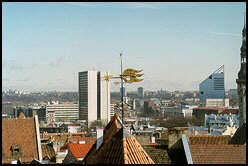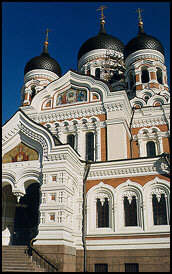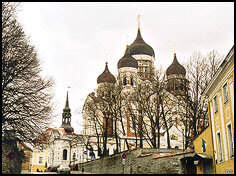 Historical introduction Historical introduction |

Estonia, officially the Republic of Estonia, (Eesti, Eesti Vabariik in Estonian), lies on the eastern shores of the Baltic Sea. The name Eesti is apparently derived from the word Aisti, the name given by the ancient Germans to the peoples living north-east of Vistula. The first to mention the Aisti was Tacitus, the Roman historian of the 1st century (Aestii). The ancient Scandinavians called the land south of the Gulf of Finland Eistland, and the people eistr. The name Estonia used in many contemporary languages comes form the Latin name Estonia. The first known registration of Estonia (Astlanda) on a map was by the Arab scholar al-Idrisi in 1154. The oldest surviving map dates from 1573.
The earliest signs of habitation in Estonia date back to the 8th millennium BC. Estonian, who belong to the Balto-Finnic group of the Finno-Ugric nations, have settled Estonia as aborigines from time immemorial. Their ancestors arrived here as far back as the 3rd millennium BC.

For the first time during the more than 5,000-year-long history of Estonians, the independence of Estonia was declared on February 24, 1918. On June 17, 1940, Soviet Union occupied the Republic of Estonia. On August 20, 1991, the parliament declared the independent Republic of Estonia to be restored (restitutio in integrum). The Constitution, adopted by plebiscite on June 28, 1992, is in force since July 3, 1992. |
Many wars have been fought in Estonia because of its strategic location. Before World War II, the territory of the Republic of Estonia covered 47,549 sq km, as a result of borders fixed by the Tartu Peace Treaty signed in 1920. Presently, the territory is 45,226 sq km. Despite that, Estonia is somewhat larger in area than Denmark, the Netherlands, Belgium or Switzerland.
Estonia is located mainly between 57o30' and 28o13' E. The distance from east to west is 350 km and from north to south 240 km. Estonia has many islands, large and small (over 1,500 in total) - the largest are Saaremaa (2,673 sq km), Hiiumaa (989 sq km), Muhu (200 sq km) and Vormsi (92.9 sq km). The sea islands combined total 4,133 sq km, the lakes 2.015 sq km (the largest are the Estonian parts of Peipsi and Pihkva Lake, and Võrtsjärv). Coastal legth is 3,794 km, and land border is 633 km long.

On January 1, 1997 Estonian's population was 1,462,130, of whom 70% lived in urban areas. Population density was 33 people per sq km. Ethnic composition (on January 1,1996) was: Estonians 953, 547 (i.e. 64.6%), Russians 420,435 (28.5%), Ukrainians 38,588 (2.6%), Byelorussians 22,521 (1.5%), Finns 13,949 (0.9%). Estonian is the state language. In religious affiliation, Lutherans have the largest number, while the Orthodox believers and Baptists are much smaller in number.
Administratively, Estonia is divided into 15 counties (maakond) and these, in turn, are divided into 245 smaller local governmental units. According to the administrative reform of 1993, the previous dual-level local government system was changed into a single-level system. Of the local governmental units, 47 are towns and 198 communes/townships, vald. Tallinn is the capital (1997 population ...
The largest towns are Tallinn, Tartu, Narva, Kohtla-Järve, Pärnu, Viljandi, Sillamäe, Rakvere.
The national holidays are January 1 (New Year), February 24 (Independence Day), Good Friday, May 1, June 23 (Victory Day - the anniversary of the victory at the Battle of Võnnu in 1919, during the War of Independence), June 24 (St. John's Day), December 25 and 26 (Christmas holidays).
The currency is the Estonian kroon (EEK: 1 kroon = 100 sents). The Estonian kroon is bound to the Deutsche mark: 1 DEM = 8 EEK)
Major dates in Estonia history |

